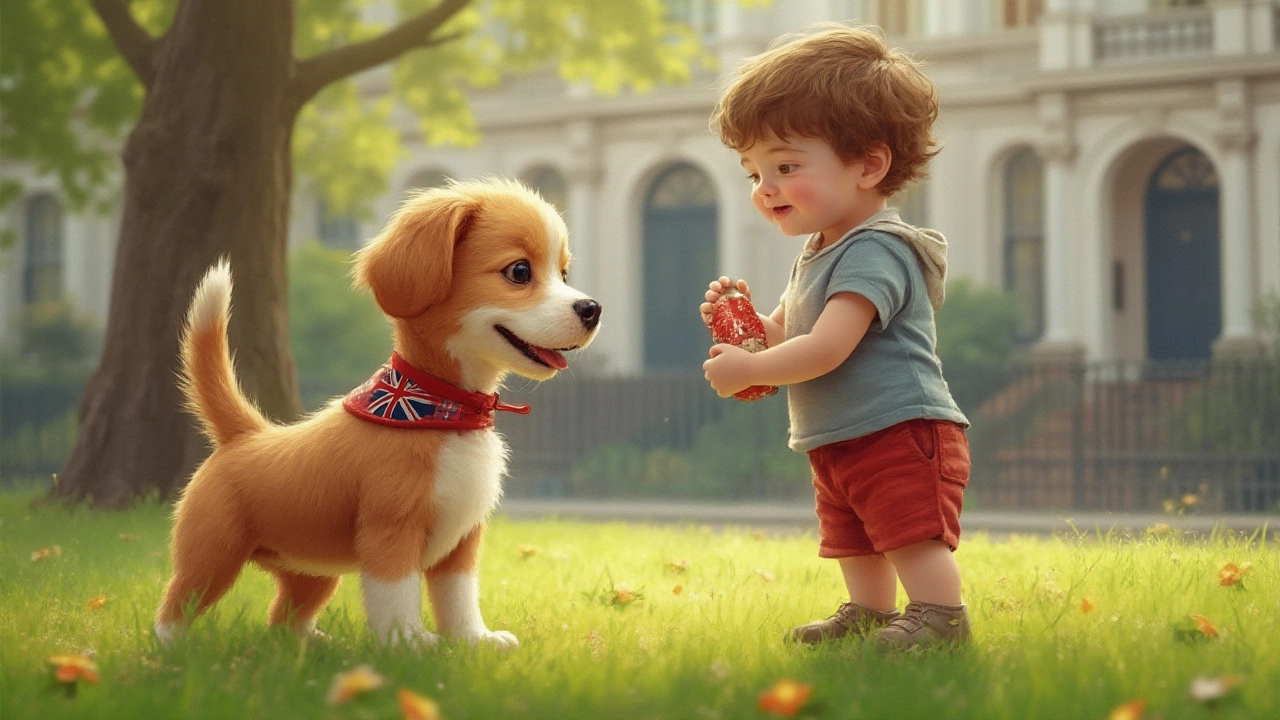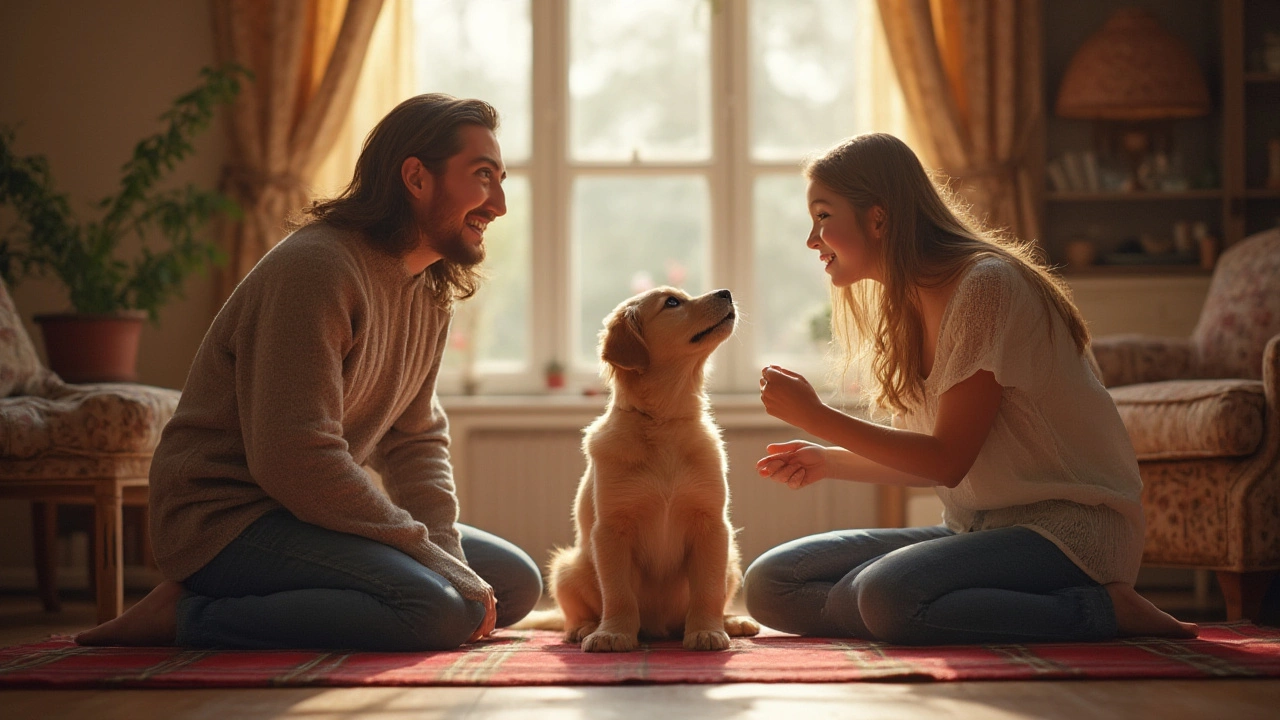Ever wondered how some puppies respond to their names so fast while others seem to ignore it completely? Naming your puppy is personal, like picking a name for a new family member. But getting your puppy to pay attention when you call that name? That's a whole different story. Lots of dog owners think puppies just "get it," like the way toddlers absorb language. Not true! Puppies are clever, but name recognition needs a little training magic—and plenty of patience.
Why Teaching a Puppy Its Name Matters
Your puppy’s name isn’t just for fun—it unlocks every bit of training you’ll ever do together. This is your puppy’s cue to focus on you, whether you’re calling them away from the neighbor’s compost or signaling dinner time. If your pup zones out when you call their name, every command afterward becomes a lost cause. Think of the name as your puppy’s tiny bridge between “chaos mode” and “paying attention to my human.”
Studies show that puppies can start to recognize their names as early as eight weeks old. The process triggers both their memory and rewards systems—they hear their special sound, see a happy face, maybe get a treat, and boom: the name means something good is coming. The key is to help them make this connection often enough that it becomes automatic.
Not all puppies learn at the same pace. Some breeds, like Border Collies and Poodles, catch on extra-fast, while stubborn or independent breeds may need extra tries. Of course, even within a litter, personalities differ. That sleepy one in the corner? They might take a little longer to care what you’re saying.
The biggest mistake? Owners who turn the puppy’s name into background noise. Calling "Sasha, Sasha" all day—or using their name when you’re frustrated—kills the magic. The name loses its special shine, and your puppy tunes you right out.
Here’s something worth noting: Research from the Journal of Veterinary Behavior in 2022 showed that puppies trained with their names as positive cues learned quicker and remained less anxious in new situations. It’s not just about being polite—it actually helps your puppy feel secure in the world and build trust with you.
I’ve heard from countless trainers (and experienced it with my own dogs). If you start right, your puppy will come running at lightning speed every time they hear their name for the rest of their life. It’s worth every bit of early effort.
Picking the Perfect Puppy Name for Training Success
This might sound silly, but how you name your puppy matters—especially in the early days. Short, sweet, and punchy names work best for training. One or two syllables are easier for puppies to recognize than a long, complicated name like “Sir Barkington Fluffybutt.” Imagine yelling that across a dog park!
Try to avoid names that rhyme with common commands. If your puppy is “Kit” and you’re teaching “Sit,” you’re in for confusion city. Puppies link sounds together—if the name sounds too much like a standard command, they’ll mix up what’s being asked.
Sharp consonants—like “K,” “P,” or “D”—catch a puppy’s attention. There’s a reason dog names like “Max” and “Bella” are so popular—they’re easy for both human and pup to say and hear. Names ending with an “ee” sound (“Maggie,” “Roxy,” “Charlie”) are also super-recognizable for little canine ears.
Even color matters. A 2023 survey by the American Kennel Club found that owners who chose names matching their puppy’s unique markings or coat color reported a speedier name-learning process. It helps the owner’s tone stay consistent and keeps the dog’s attention piqued.
When you’re naming your puppy, say the name out loud a bunch of times. Testing with excited, happy voices and silly faces works wonders. If it feels awkward, it probably is. Your puppy feeds off your energy, so pick a name you can say joyfully for years without cringing.
And if you adopt an older puppy with a name you don’t love? You can absolutely change it. Spend a few days pairing the new name with treats, cuddles, and fun. Dogs are great at learning new associations—they just need clear signals from you.
- Short names (1–2 syllables) are easier for puppies
- Don’t pick names that rhyme with common commands
- Names with sharp consonants and "ee" endings catch attention
- Match the name to your puppy’s look or personality for easier recall
- Practice saying the name in a happy, enthusiastic way

Step-by-Step Guide: Teaching Your Puppy to Recognize Its Name
Ready for the main event? Teaching your puppy its name doesn't have to be a chore. If you stick to small, daily "training snacks," you’ll see results fast. Here’s how the pros do it, with tips I’ve personally seen work wonders—even with the most distracted, wiggliest pups.
- Grab your puppy’s attention. Find a quiet space where your puppy isn’t distracted—no bustling kitchen, TV, or kids zooming by. Stand a few feet away from your puppy.
- Say your puppy’s name once, with a cheerful, excited tone. No robot talk—think of the way you’d call a friend’s name at a party.
- The moment your puppy looks at you, immediately reward them. Use a small training treat, their favorite toy, or a big burst of praise. Timing is everything here—your reward has to come while they’re still looking at you.
- If your puppy ignores you, make a funny noise or crouch down to encourage curiosity. Don’t repeat the name over and over—just try again when you have their focus.
- Repeat this five to ten times, then take a break. Puppies have the attention span of a goldfish (really, about 2–3 minutes max), so keep sessions short and fun.
- Once your puppy consistently looks at you when you say their name, try adding distractions. Practice outside, at the park, or even in a doorway with friendly chaos in the background.
Here’s a quick table with session ideas and progress pointers:
| Session | Where to Practice | Goal | Common Mistake to Avoid |
|---|---|---|---|
| 1–3 | Quiet room at home | Puppy looks at you for name + treat | Repeating the name too much |
| 4–7 | Backyard or porch | Puppy responds even with birds or new sounds | Getting frustrated if puppy is distracted |
| 8–12 | On walks, busy rooms | Puppy snaps to attention anywhere | Using the name as a scolding tool |
Never use your puppy’s name when they’re in trouble. They’ll start to associate the sound with negative moments. The golden rule: The name should always mean good things—fun, food, adventure, or attention.
Mix it up for variety—use your puppy’s mealtime, play, and leash-up moments as name-response opportunities. Puppies love predictability, so build the name into your daily routine. Example: “Bella!” and shake the food bowl for breakfast, “Bella!” and pat your knee before a walk.
Two dogs at home? Teach each name separately. No joke—I’ve seen littermates answer to both names if you train together without separating the cues. Call one puppy, reward only that one. Otherwise, they’ll think “MaxRosie” is their shared new name.
If your puppy starts ignoring their name, backtrack. Try again in a less-distracting spot, up the reward, or add a squeaky or silly sound right before the name. And if you slip up and use the name in a no-no context (like yelling when they eat your socks), follow it up quickly with a round of positive name games to refresh the happy association.
- Training sessions should be short and positive
- Always follow the name with a reward
- Slowly increase distractions as your puppy gets better
- Never pair the name with punishment
- In multi-dog homes, train one puppy at a time
Troubleshooting Tips and Advanced Puppy Name Games
Sometimes, even with all the right steps, your puppy doesn’t seem interested. Maybe they’re shy, extra playful, or too distracted by the big world. Don’t sweat it. Here’s how to troubleshoot some classic speed bumps:
- If your puppy flat-out ignores their name, try raising the value of your reward. Use tiny pieces of boiled chicken, a squeaky toy reserved just for training, or lots of excited cheerleading.
- Does your puppy only respond indoors? Practice in small outdoor bursts, gradually moving to more distracting places. Bring back the big rewards when introducing new environments.
- If you have a rescue puppy or an older pup, remember: they might have baggage with certain names. Go slow and pair their new name with nothing but positives.
- Accidentally used your puppy’s name in a mad tone? Don’t panic. Just follow up with several “name—reward” rounds to reset the association.
Ready for level two? Once your puppy knows their name, add a few games to keep them sharp and make the training more fun for both of you:
- Name Game Tag: Take turns with family members calling your puppy’s name from different rooms or from opposite ends of the yard. Each time your puppy finds the “caller,” jackpot them with praise and a treat.
- Name Ball: Roll a toy or ball, say your puppy’s name, and encourage them to bring it back. This helps build excitement around their name and strengthens recall.
- Hide & Speak: Hide behind a door or a bush, then call your puppy’s name once. When they find you, give them loads of love. This game doubles as a confidence booster for shy pups.
- Name at a Distance: Practice your puppy’s name while they’re facing away or distracted. You want their ears to perk up even if you aren’t right in front of them.
Keep your training pace relaxed—no need to rush. Some puppies are lightning-fast learners, while others are slow and steady. The average puppy starts clearly responding to puppy name training within a week of daily practice, but every dog has their own time table. If you stay consistent, you’ll see progress.
Real talk? Teaching your puppy their name is about more than just getting their attention—it lays the groundwork for trust, communication, and all the fun stuff you’ll do together for years to come. Put in the time now, and you’ll always have your little sidekick looking up whenever you call. And honestly, is there anything better?

